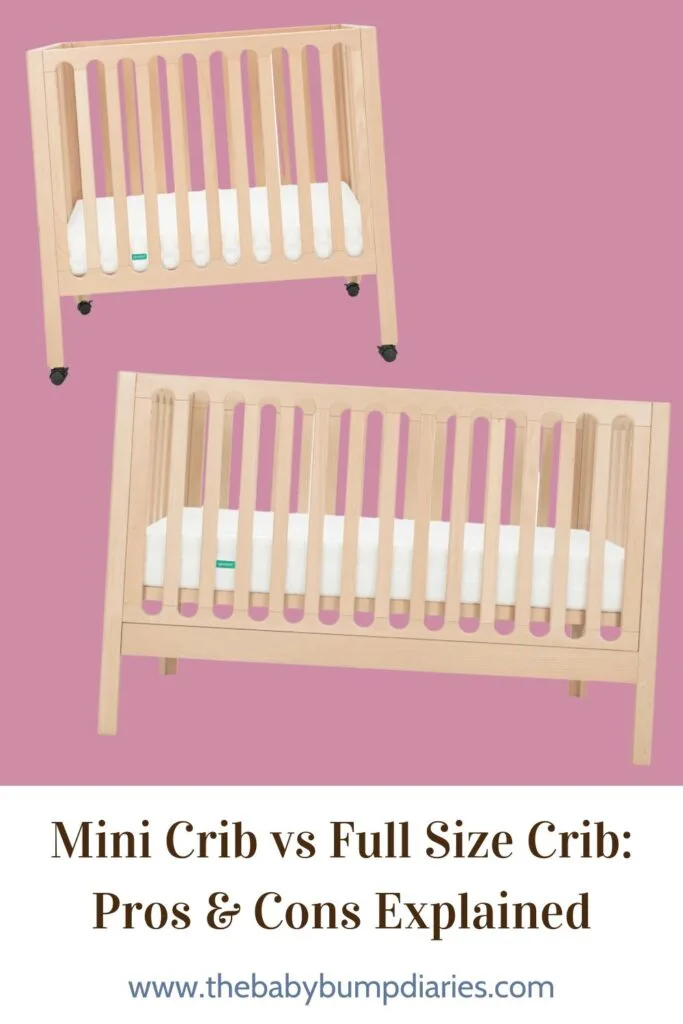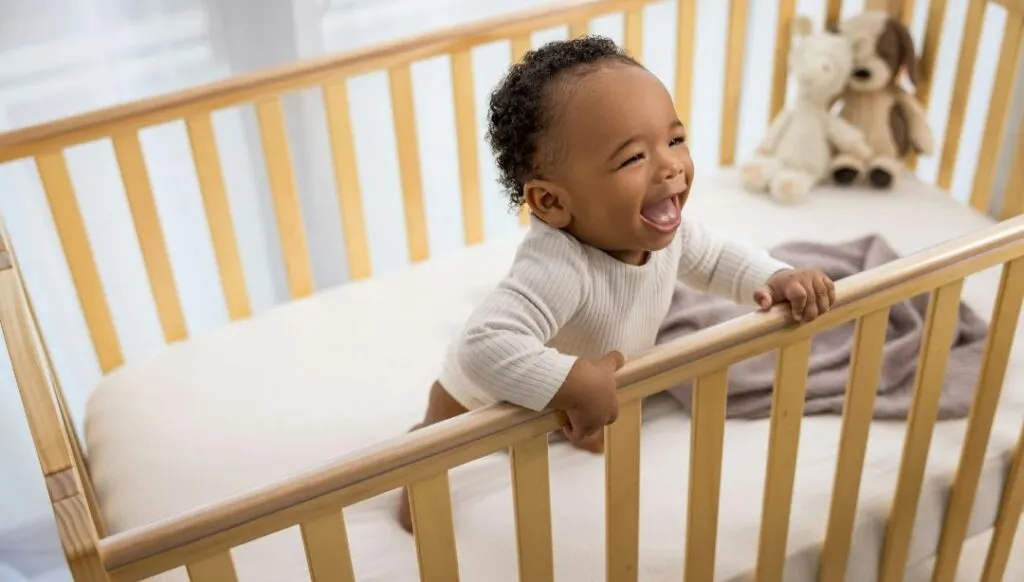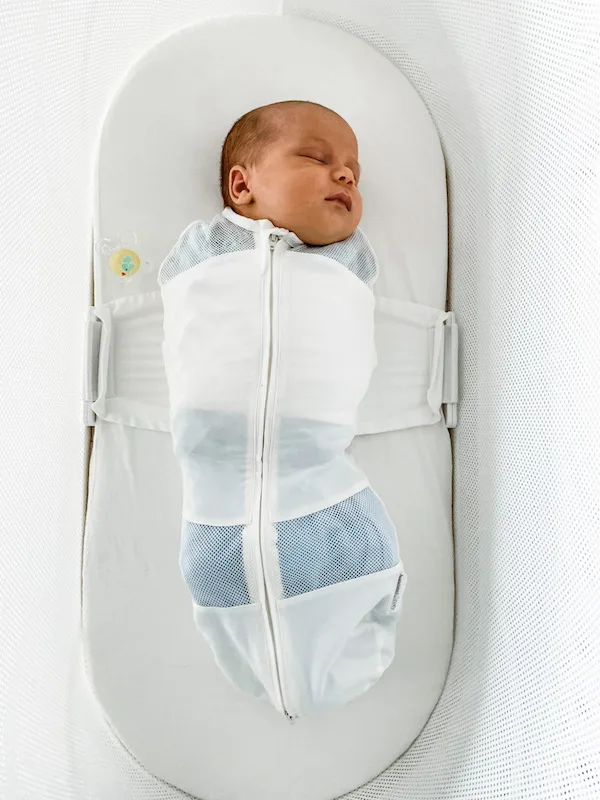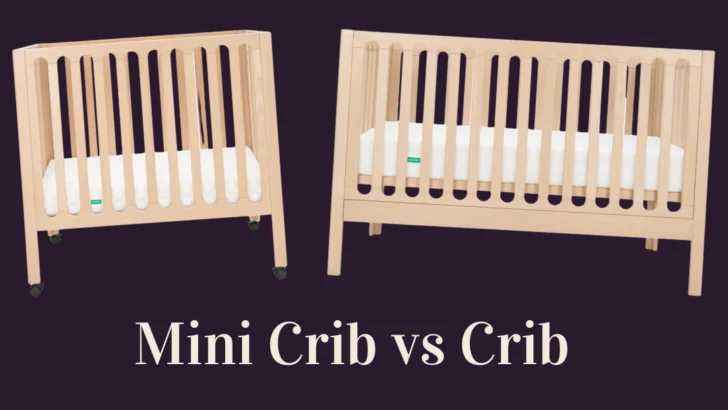If you’re preparing your baby’s nursery, you might have encountered the mini crib vs. crib dilemma.
Both have their advantages and disadvantages, so let’s dive in and explore the ins and outs of mini cribs vs. cribs to help you make the best choice for your little one’s cozy haven.
What is a Mini Crib?
A mini crib, as the name suggests, is a smaller version of a standard baby crib.
If you’re working with a small space or you’re sharing a room with your baby, it can be the perfect, compact sleeping solution.
Mini Crib vs. Crib Comparison Table
The main difference between mini cribs and full-sized cribs is the size. But there are some other key differences to think about:
| Aspect | Mini Crib | Crib (Standard) |
|---|---|---|
| Size | More compact | More spacious |
| Space Requirements | Ideal for small rooms or shared spaces | Requires more space |
| Age Range | 0-18 months | Up to 3.5 or more if convertible |
| Portability | Lightweight and easy to move; typically on wheels | Heavier and less mobile |
| Conversion Options | Limited conversion possibilities | Convertible options for future use |
| Cost | Generally more affordable | May be more expensive |
Now, let’s dive deeper into each aspect to help you make an informed decision.

Pros and Cons of Mini Cribs vs. Cribs
Mini Crib Pros:
- Space-Saving: Mini cribs are perfect for smaller spaces like tiny nurseries or apartments with limited space. They offer all the essential features of a standard crib but in a more compact package.
- Portability: Mini cribs are usually lighter and easier to move around. This makes them a great choice if you want to have your baby sleep in different rooms.
- Affordability: Mini cribs are often more budget-friendly than their full-sized counterparts, which is a big plus if you’re on a tight budget. It’s also a lot easier to add this to your baby registry, thanks to the lower price point.
- Cozy Feel: Some parents find that the smaller size of mini cribs creates a cozier environment for their baby.
Mini Crib Cons:
- Limited Lifespan: Mini cribs are only meant to be used up to around 18 months, so you’ll need a plan for after that point. And in those early months? Time FLIES. You’ll need to have something in place faster than you may realize.
- Less Sturdy: Because mini cribs are smaller, they’re more lightweight, which makes them less sturdy.
- Fewer Sheet Options: It’s not a huge deal in the age of Amazon, but there aren’t as many options for mini crib sheets. A standard crib-sized fitted sheet is more popular, so more manufacturers sell them, providing many pattern and color choices.
Related: Crib Weight Limits: Can I Get In My Baby’s Crib?
Crib (Standard) Pros:
- Longevity: Standard cribs are designed to accommodate your child as they grow. Many can convert into toddler beds and even full-sized adult beds, providing long-term value.
- Ample Space: Standard cribs offer more sleep space for your baby.
- More Sheet Options: since regular cribs are the standard, you have a whole world of choices when it comes to crib sheets and finding the colors and patterns that fit your nursery aesthetic.
- Sturdy: standard cribs are larger, and thus heavier, than mini cribs, offering more stability and durability.

Crib (Standard) Cons:
- More Space: Standard cribs take up more space, which can be a challenge for those with a small nursery.
- Heavier: These cribs are heavier and less mobile, making it harder to move them around or transport them.
- Higher Cost: Standard cribs tend to be pricier compared to mini cribs, which can put a strain on your budget.
Mini Crib vs. Crib Dimensions
If you’re doing space planning, the size of a mini crib vs regular size cribs may make the decision pretty easy. that said, even regular cribs have different sizes, depending on the brand.
Here are the typical dimension ranges for regular vs mini cribs:
- Dimensions of a mini crib:
- 38-40 inches long
- 25-28 inches wide
- 32-39 inches high
- Dimensions of a full size crib:
- 53-54 inches long
- 29-33.50 inches wide
- 29-35.5 inches high
Obvoiusly, if you have less space or a smaller footprint, a mini crib is probably the way to go, at least temporarily.
Bassinet vs. Mini Crib
If you’re thinking about a mini crib, it’s worth looking into bassinets, too.
Bassinets are ideal for the first few months of a baby’s life, specifically a newborn baby. They’re easy to move, are perfect for right next to your bed (hello, nursing moms!), and are generally pretty light.
I personally think the biggest difference between a bassinet and a mini crib is the extra built-in features. A lot of bassinets have nice features like white noise, storage space, and a swivel for middle-of-the-night feeds.
The obvious downside if they’re not for long-term use.
We used the SNOO, and it only worked for our baby until about 5 months old. It was a lifesaver, though…

A mini crib is more spacious than a bassinet and can be used up to 18 months old, but it doesn’t come with the bells and whistles most bassinets do.
Mini Crib vs. Crib FAQs
Mini cribs are great for small spaces, while regular cribs offer more long-term use and features. Neither is inherently better than than the other – it just depends on your needs.
Mini cribs are suitable for infants and young toddlers, typically up to 2 years old.
Folding mini cribs can be safe if they meet safety standards, but it’s essential to ensure proper assembly and usage. Hardware failures are one of the most common reasons babies get injured in cribs!
Related: Will I Break My Baby’s Crib If I Get In? Safety Tips
Mini cribs may have a shorter lifespan, less storage space, and limited conversion options compared to standard cribs.
Mini cribs are worth it if you have limited space or need a portable crib. They are more budget-friendly but have a shorter period of use.
Mini cribs are practical for small nurseries, as a portable crib, or for grandparents’ homes.
You’d choose a mini crib for space-saving, portability, or budget considerations.
Mini cribs require a specific-sized mattress that is smaller than a standard crib mattress.
Yes, mini cribs are suitable for newborns, but ensure proper bedding and a snug-fitting mattress.
Mini crib mattresses are thinner to fit the smaller crib size and maintain safety standards for safe sleep.
Mini cribs offer a more permanent sleeping solution, while pack n plays are versatile for travel and play.
Yes, a mini crib can replace a bassinet, offering a secure and long-term sleep option for your baby.
Conclusion
At the end of the day, the choice between a mini crib, a standard crib, or a bassinet depends on your specific needs, nursery space, and budget.
Our family did a bassinet for the first few months in our bedroom and then transitioned into a full-size crib, specifically, a convertible crib, in the baby’s room. It was the best decision for us at the time.
I can’t help but feel like the better choice is investing in a traditional crib, as opposed to a mini crib. You’ll have to buy less baby gear in the long run, and most cribs these day convert into toddler beds and beyond.
What do you plan to do in the mini crib vs crib battle? Let me know in the comments!
Related: Top 8 Questions You Need to Ask Before Using a Crib Mattress in a Toddler Bed
Yasmin is a writer and mother of two young children. She is also the woman behind Two Mama Bears, a blog for parents with babies and toddlers.

